Chile: Walking with Pumas 2022 September tour 1
6 November 2022






































































































Like a scene from a cosy, fireside story, a female puma wraps her long tail protectively around her cubs (image by Virginia Wilde)

A puma cub jumps onto a small boulder – but then quickly decides he wants to get down! (image by Virginia Wilde)

Surveying her realm (image by Virginia Wilde)

An alert female puma – ever watchful of her mischievous cubs – watches on while making her way through the shrubby vegetation (image by Virginia Wilde)

Two puma cubs gaze at each other while on a low ridge, backdropped by the iconic ‘towers’ of Torres del Paine (image by Virginia Wilde)

Two puma cubs play amid the pale thrombolite rock structures that live along the shores of Lake Sarmiento, Patagonia (image by Virginia Wilde)

Two puma cubs gaze at each other, on a ridge with the tip of the Almirante Nieto mountain, part of the Paine Massif, showing behind (image by Virginia Wilde)
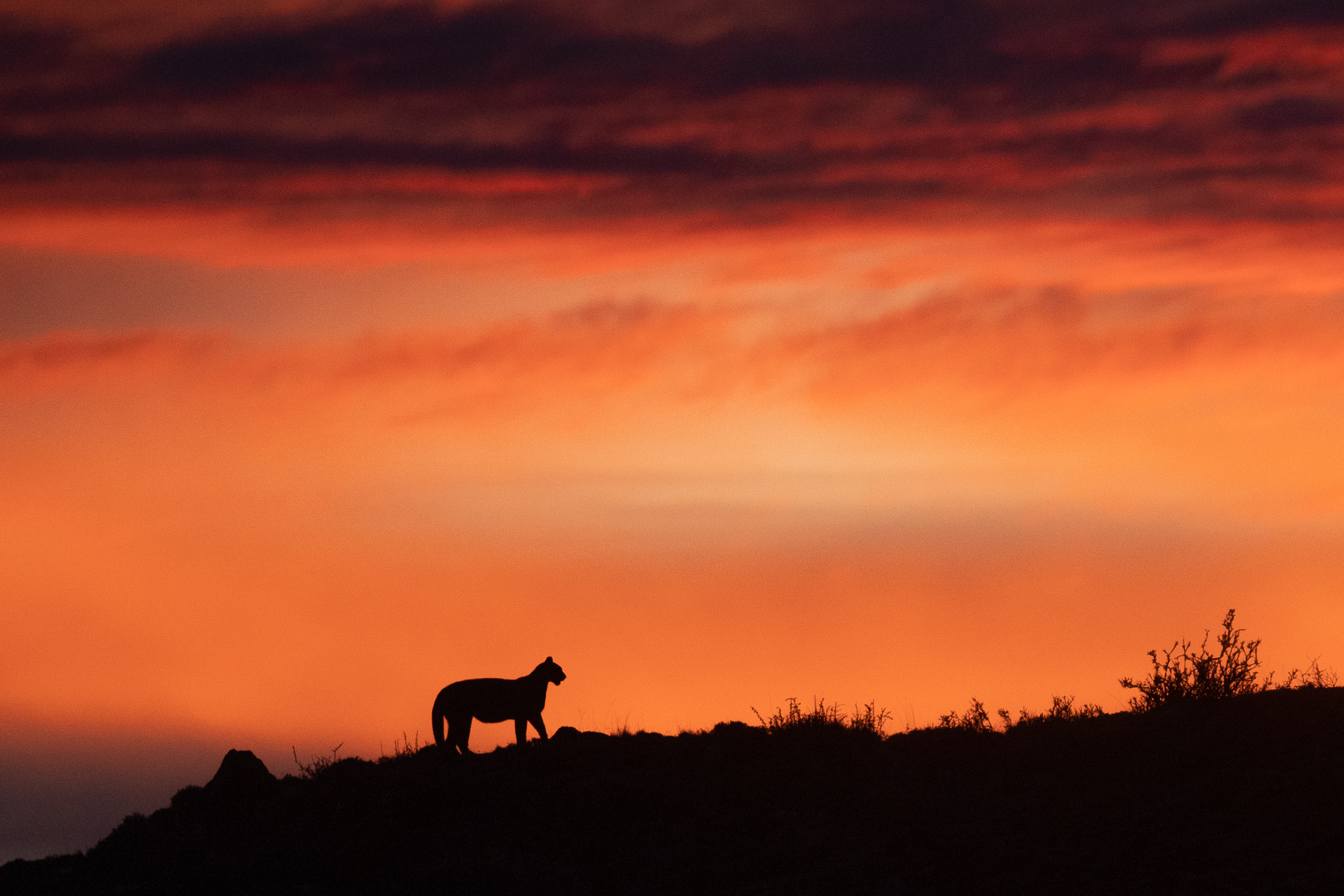
Silhouetted against a brilliant orange sunrise sky, a puma slowly climbs a ridgeline (image by Virginia Wilde)

Lying in yellow grass, a female puma appears relaxed and well-camouflaged in this terrain (image by Virginia Wilde)

A female puma and her cub lie on a low ridge, backdropped by the iconic ‘towers’ of the Paine Massif mountain range (image by Virginia Wilde)

A female puma balances one paw on a small rock, showing the size of one of her powerful paws, used to grab and grip prey and aid jumping (image by Virginia Wilde)

A puma cub lies beside the yellow line of the road that heads up across the Laguna Reserve and into the Torres del Paine National Park (image by Virginia Wilde)

A white-throated Caracara flies up from grassland in the Torres del Paine National Park (image by Virginia Wilde)

A female puma in front of her kill (image by Virginia Wilde)

Female pumas on a kill (image by Virginia Wilde)

This South American Grey Fox was one of three we found feasting on a sheep’s carcass, believed to have originally been killed by a puma (image by Virginia Wilde)

Looking majestic – but straight at me – a female puma stands with her front paws on a rock (image by Virginia Wilde)

Female Puma And cub, against a backdrop of the Sierra Baguales Mountains (image by Virginia Wilde)

The pale grey coat of a year-old male puma cub (image by Virginia Wilde)

A female puma looks adoringly at her cub on a hillside across from the Sierra Baguales mountain range (image by Virginia Wilde)

Two puma cubs play beside their mother on a beautiful warm morning in Patagonia, with the tip of the Almirante Nieto mountain behind (image by Virginia Wilde)

Having spent almost an hour feeding on a guanaco kill - as large flakes of snow fell – this puma’s nose and chin were stained with blood. Which can be a disconcerting sight, if a wild predator like this then stares right at you! (image by Virginia Wilde)

It’s not every day that you see a puma cub parked over a yellow line. Two puma cubs lie across the road that heads up across the Laguna Reserve (image by Virginia Wilde)

‘Are you sure that rock is big enough to stand on?’ A puma manages to get all four paws on a small rock, but fails to look quite as majestic on this mini stone as on a big boulder (image by Virginia Wilde)

Two puma cubs play beside their mother on a beautiful warm morning in Patagonia, with the tip of the Almirante Nieto mountain behind (image by Virginia Wilde)

Two puma cubs – one male and one female - play amid the pale thrombolite structures – rocks bearing microbial fossils – that live along the shores of Lake Sarmiento (image by Virginia Wilde)

Puma cubs spend hours each day play-fighting which serves a social and bonding function. And it’s also great fun! (image by Virginia Wilde)
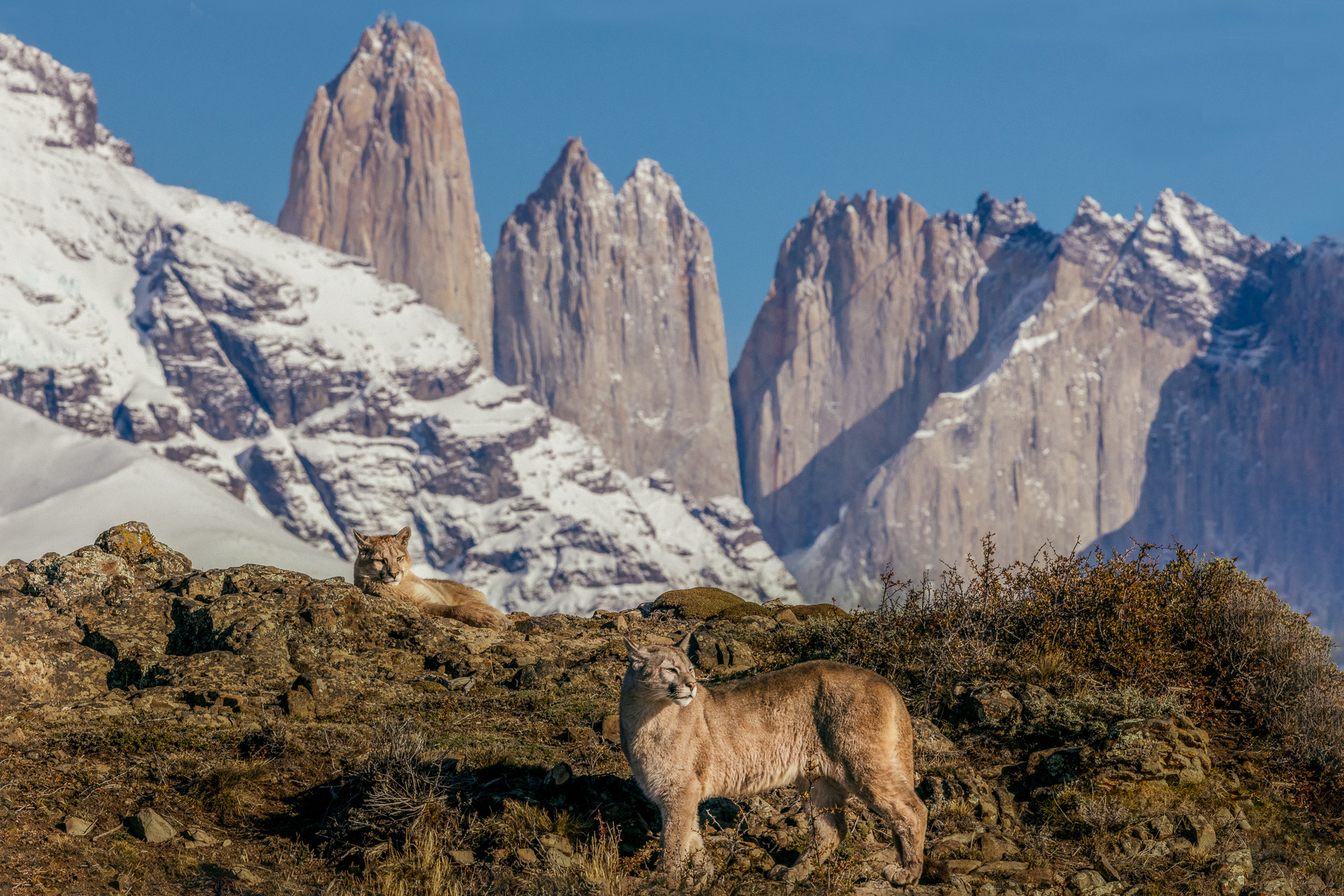
Two puma cubs – one standing, one sprawling – in front of the iconic ‘towers’ of the Paine Massif mountain range, Torres del Paine, Patagonia (image by Virginia Wilde)

An animated female puma, moments before bounding back across the pampas to chase her two cubs (image by Virginia Wilde)

Two puma cubs lie side by side on a low ridge, backdropped by the iconic ‘towers’ of the Torres del Paine Massif mountain range (image by Virginia Wilde)

A puma cub looks out across the hillsides towards the Sierra Baguales mountain range, Patagonia (image by Virginia Wilde)

A puma cub in warm morning light near the tip of the Almirante Nieto peak, part of the Torres del Paine Massif (image by Virginia Wilde)

Looking straight at us, an inquisitive male puma cub, relaxed after drinking from a pool (image by Virginia Wilde)

A female puma bounds through low pampas grass, before catching up with her cubs who had disappeared below a ridge to continue their bouts of play-fighting (image by Virginia Wilde)
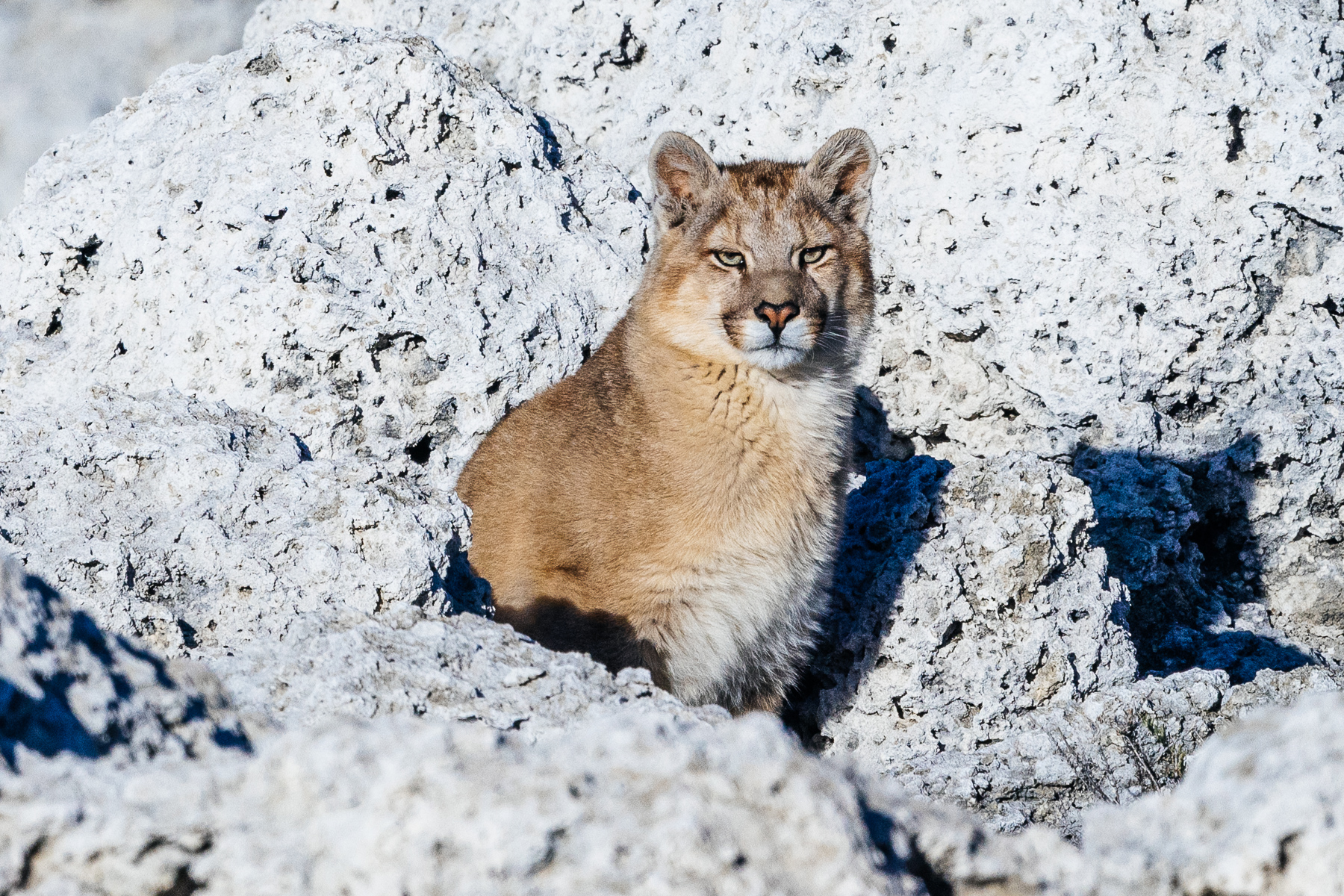
With its pale coat standing out against the even paler rocks, this puma cub peeks out from the thrombolites of Lake Sarmiento (image by Virginia Wilde)

A Black-chested Buzzard Eagle we found sat atop a pole near Punta Arenas, Chile, still showing some traces of juvenile brown plumage (image by Virginia Wilde)

An alert female puma – ever watchful of her mischievous cubs – stands looking on in the rocks (image by Virginia Wilde)

Three puma heads are better than one! A mother puma and her cubs curl up together in the warm morning sunshine (image by Virginia Wilde)

The fearsome dominant male puma of the Laguna Amarga reserve – known as ‘Dark’ – in front of his latest guanaco kill (image by Virginia Wilde)
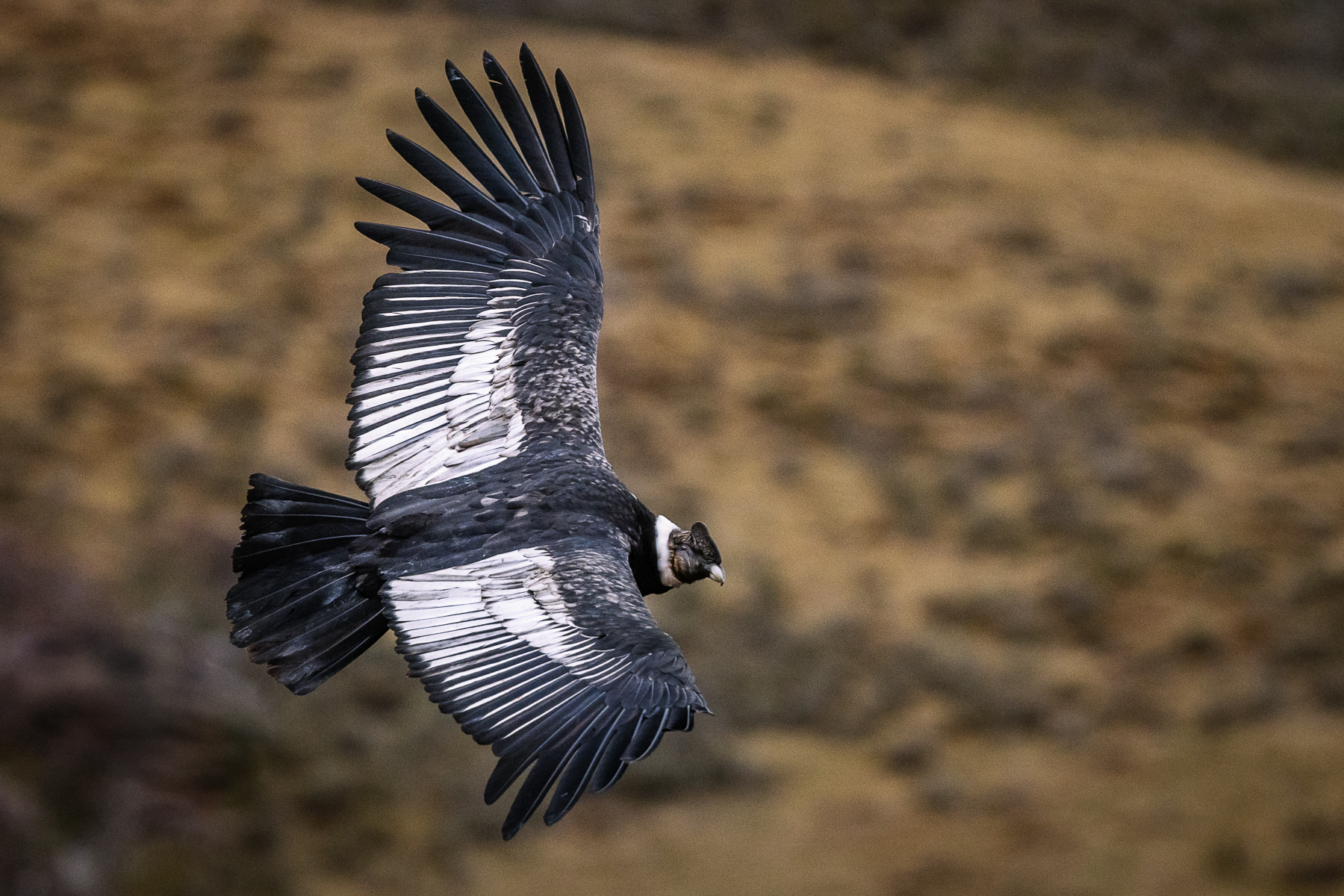
A male Andean Condor, showing the yellow/brown eye, distinctive white collar and comb that distinguish them from the female (image by Virginia Wilde)

A female puma with her cub, on grassland in front of the Sierra Baguales mountains (image by Virginia Wilde)
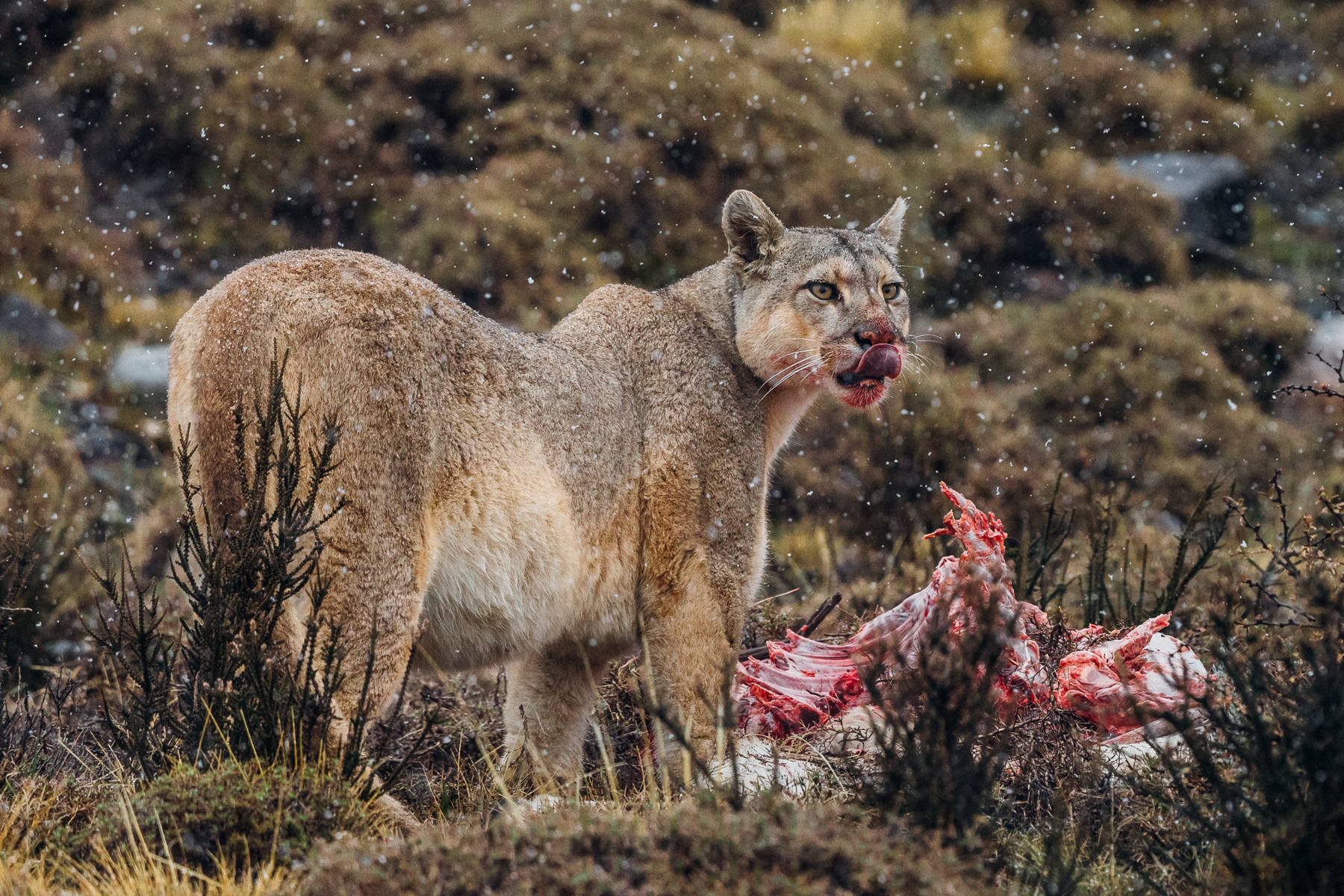
In front of a freshly killed guanaco this hungry puma licks her lips between mouthfuls, as snow falls all around her (image by Virginia Wilde)

A distant view of the Paine Massif – showing the iconic ‘towers’ – reflected in the waters of the Laguna Amarga (image by Virginia Wilde)

Thanks for the sock to the head, brother! Puma cubs stay with their mothers for up to two years, developing their hunting skills through long bouts of play-fighting (image by Virginia Wilde)

‘Alright mum, I will behave!’ A female puma keeps her cub in check, before the pair indulged in some affectionate play-fighting (image by Virginia Wilde)

Backdropped by the mountains of the Paine Massif, a puma sits along the ridge line (image by Virginia Wilde)

Female Puma basking in the evening light (image by Virginia Wilde)

'Now where did my cubs go?' (image by Virginia Wilde)

This female puma picked up a scent and spent almost a whole minute with her nose raised, sniffing the air in front of her (image by Virginia Wilde)

One of many magnificent puma sightings on our tour (image by Virginia Wilde)

‘Okay, I made it to the rock, but I’m not getting my paws wet!’ A puma cub jumps onto a small rock on the shores of Lake Sarmiento (image by Virginia Wilde)

The distinctive long tail of a puma, which these particular Big Cats need for balance amid the leaping and climbing required in their mountain terrain (image by Virginia Wilde)

Following directly behind her mother, matching her footsteps, a female cub marches downhill with her mum (image by Virginia Wilde)

A Flightless Steamer Duck at the Seno Skyring – a sound that connects with the Pacific end of the Strait of Magellan (image by Virginia Wilde)

Are we keeping you up?! A puma cub yawns while lying on a ridge in front of of iconic ‘towers’ of the Torres del Paine Massif (image by Virginia Wilde)

‘If you box my ears, I’ll box your nose!’ Two puma cubs playfight in the pampas grass (image by Virginia Wilde)

Short-eared owl on a tree-stump, showing the mottled tawny plumage of its species (image by Virginia Wilde)

"Hmmmm delicious!" a female Puma licks her lips while dining on her Guanaco prey (image by Virginia Wilde)

Two puma cubs – one male, one female – sit side by side against the backdrop of the Almirante Nieto mountain, Torres del Paine (image by Virginia Wilde)

A female puma and her sister share a guanaco kill. Pumas are noted for their sharing kills, an unusual habit for normally-solitary hunters (image by Virginia Wilde)

A lone puma cub walks along a low ledge, while backdropped by the iconic ‘towers’ of the Torres del Paine Massif (image by Virginia Wilde)

The distinctive ruby red eyes of the Fire-eyed Diucon – a grey flycatcher endemic to southern South America (image by Virginia Wilde)

Feasting on a green bud, this Rufous-collared Sparrow (also known as the Andean Sparrow) is both a regular sight in Patagonia, and also has a distinctive whistle and trilling song (image by Virginia Wilde)

A male puma cub walks slowly towards his sister, wanting to play (image by Virginia Wilde)

Half-awake, half dozing in the warm Spring sunshine, this South American Grey Fox found a rock to lie against, just metres from a puma and her cubs (image by Virginia Wilde)

Two black-faced Ibis suddenly take to the sky, in front of the Sierra Baguales mountains, Patagonia, startling two puma cubs and their mother who were resting below (image by Virginia Wilde)

Lying in yellow grass, a female puma appears relaxed and well-camouflaged in this terrain (image by Virginia Wilde)

The stunning red breast of the male Long-tailed Meadowlark, regularly seen on our tours and one that never fails to catch the eye (image by Virginia Wilde)

A female puma races up the hill towards her cubs, just metres from their guanaco kill (image by Virginia Wilde)

Lying on a ridge together, a female puma and her two cubs, backdropped by the mountains (image by Virginia Wilde)

A herd of guanacos track along a ridge line, with the curves of Lake Sarmiento below (image by Virginia Wilde)

These two eleven-month-old cubs – a male and his younger sister – stare intently into the distance, where a herd of guanacos traverse across a ridge (image by Virginia Wilde)

This female puma picked up a scent and spent almost a whole minute with her nose raised, sniffing the air in front of her (image by Virginia Wilde)

Female Puma with her two cubs in front of the famous towers of Torres Del Paine (image by Virginia Wilde)

A female puma yawns, showing the powerful jaws and strong canine teeth that make her such a strong hunter. Her cub watches from behind (image by Virginia Wilde)

Like all cats, pumas love lying out in the sun. The evening light makes this puma’s coat shine brightly, before the sun begins to drop below the horizon (image by Virginia Wilde)

A Dark-bellied Cinclodes rests on a rock, in front of a stream in the Torres del Paine National Park (image by Virginia Wilde)
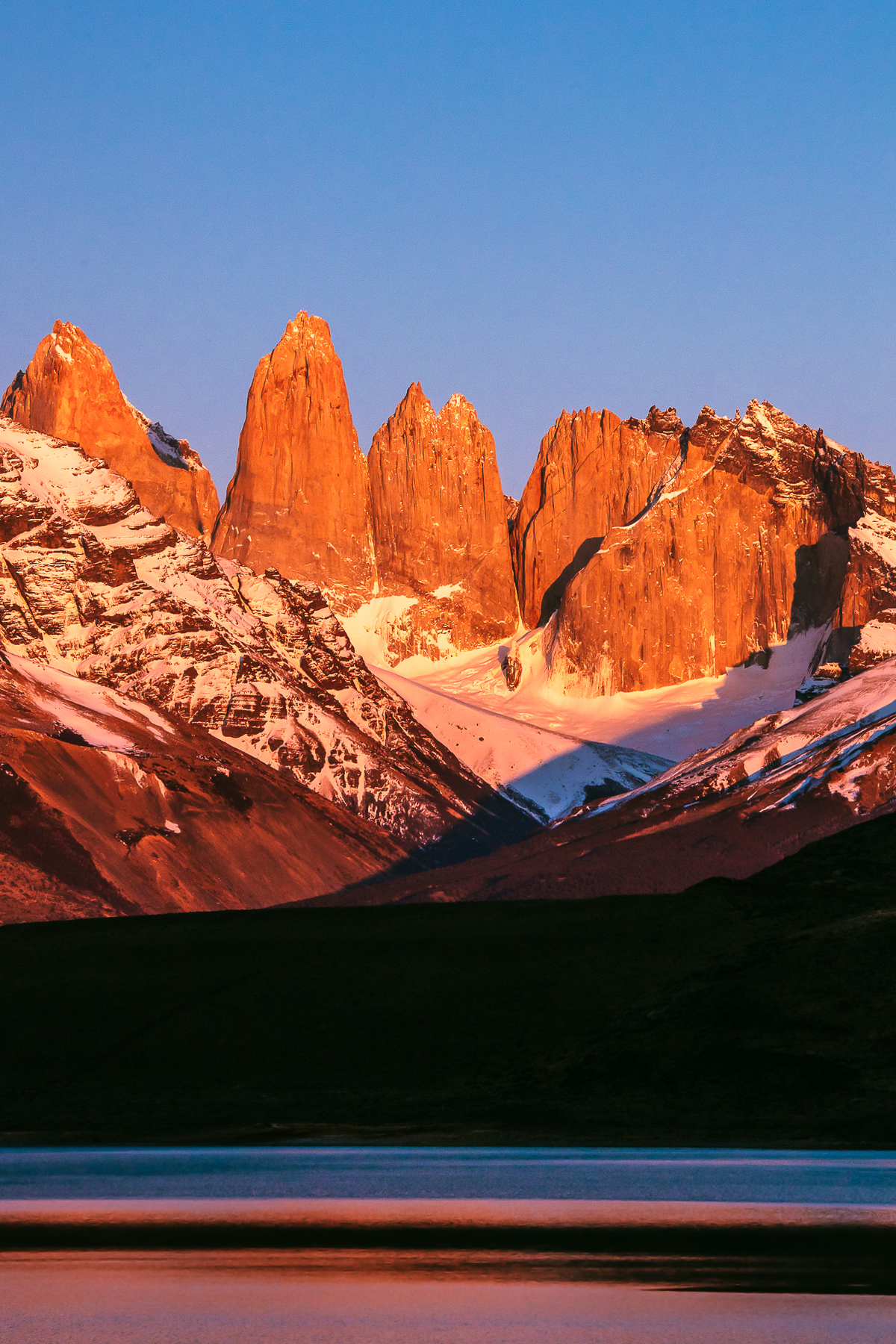
The famous ‘towers’ of the Paine Massif, Torres del Paine National Park, glow orange in the morning sunrise, with winter snow still gathered in the mountains’ valleys (image by Virginia Wilde)

Locking eyes with a South American Grey Fox - one of three we found feasting on a sheep’s carcass (image by Virginia Wilde)

After having an afternoon snooze, this South American Grey Fox rose to climb down from a ridge above Lake Sarmiento, before padding across some mudflats (image by Virginia Wilde)

Pumas make excellent mothers, and stay with their cubs for up to two years (image by Virginia Wilde)

A female puma and her cub walk side-by-side in lockstep from Lake Sarmiento and towards the road (image by Virginia Wilde)

Female Puma in beautiful morning light (image by Virginia Wilde)

Looking straight at me, an inquisitive male puma cub, relaxed after drinking from a pool. Patagonia (image by Virginia Wilde)
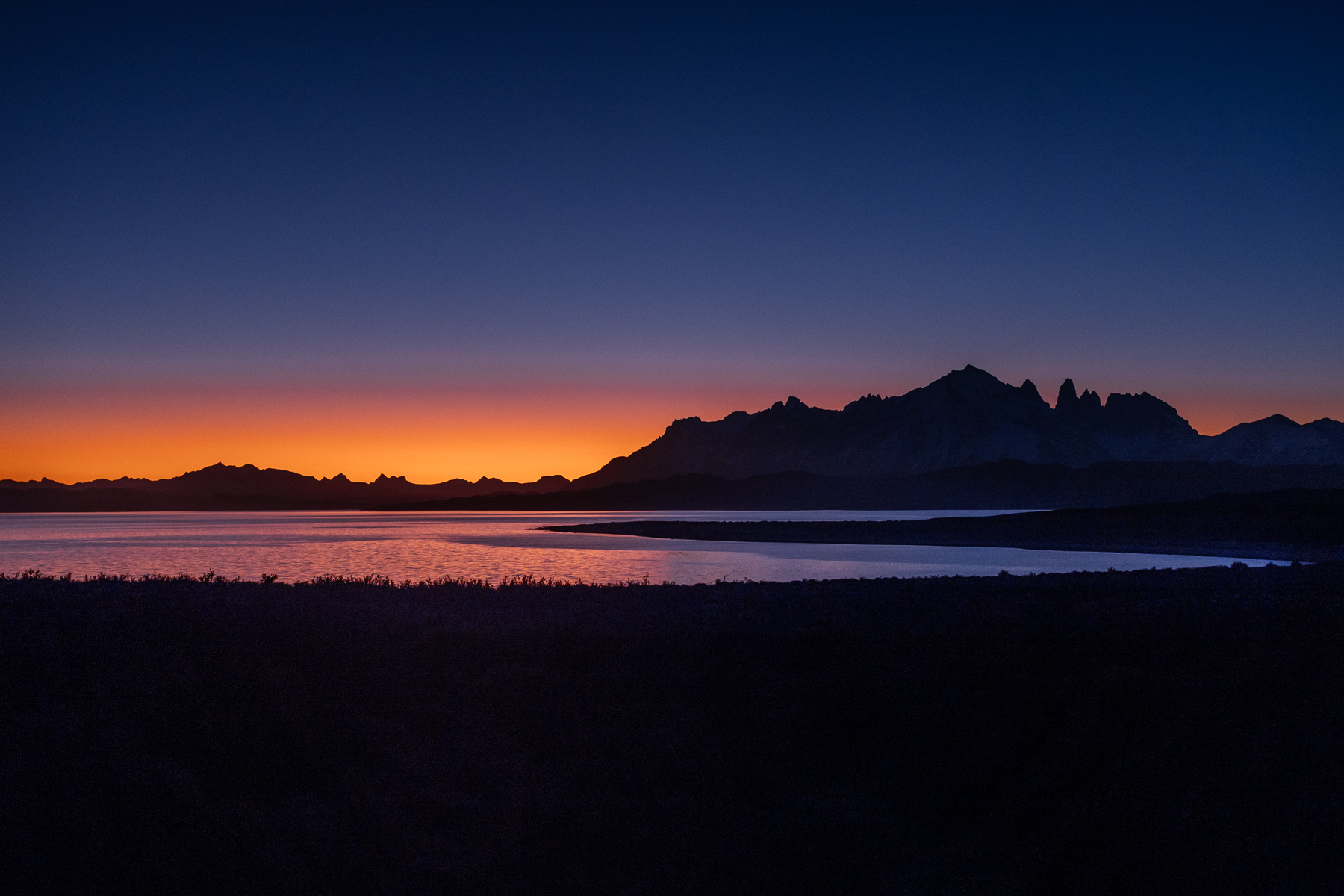
The sunsets in Patagonia can be breathtakingly beautiful. Here the sun has dropped below the horizon, and nearly all the colours have gone except a mesmerising glow (image by Virginia Wilde)

Alerted by the sound of flying Black-faced Ibis, suddenly darting above, this female puma cub looked skyward (image by Virginia Wilde)

After heading to a pool to drink, a female puma crosses just a few feet in front of us, before calling for her cubs (image by Virginia Wilde)
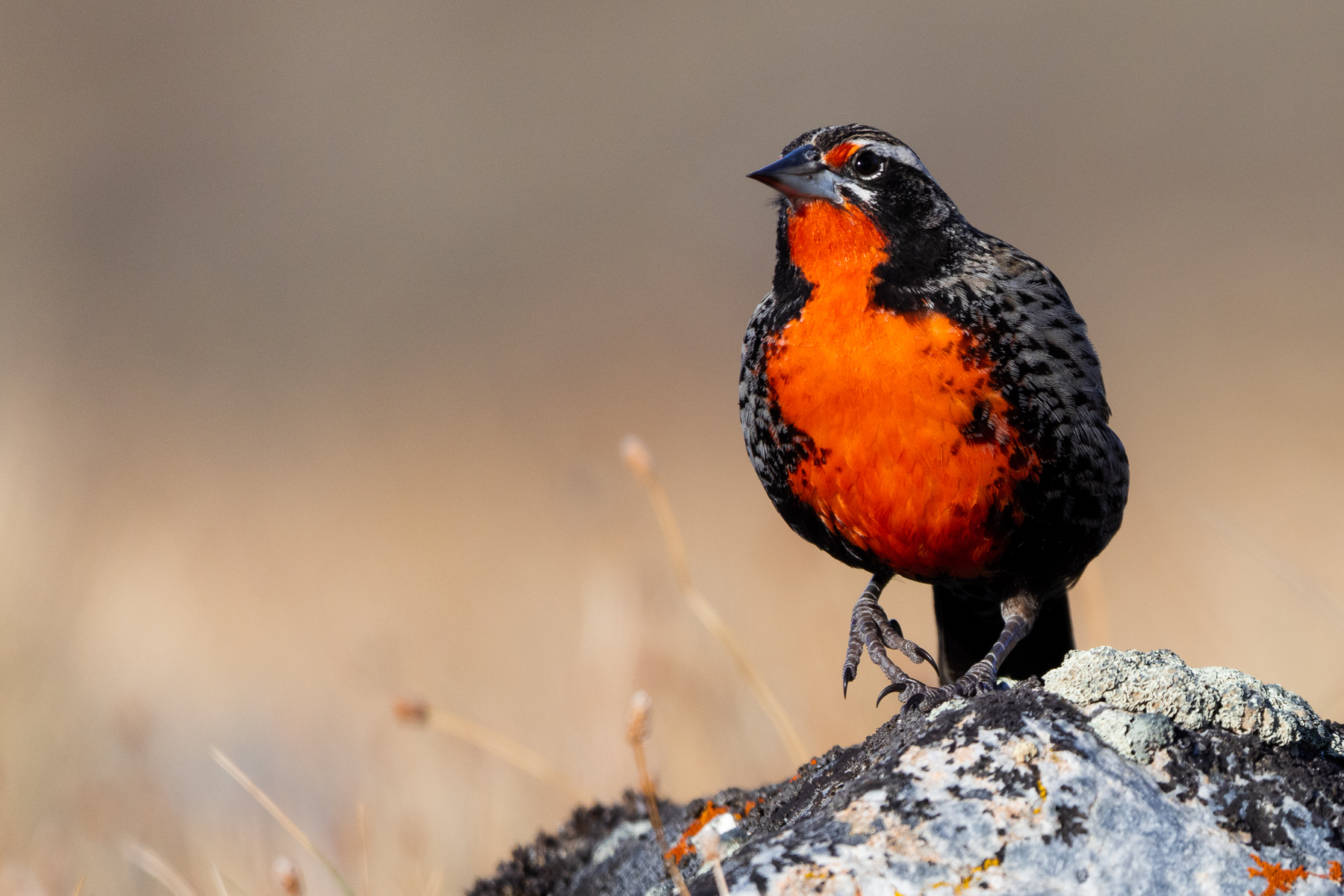
The stunning red breast of the male Long-tailed Meadowlark (image by Virginia Wilde)

A juvenile Andean Condor, showing the brown plumage that these birds keep until around six years old, flying over farmland and almost at eye-level (image by Virginia Wilde)

Guanaco with the morning light glowed off its coat, against the dark blue of the Torres del Paine Massif mountain range (image by Virginia Wilde)

A six-month-old puma cub pads down towards the lake over the pale thrombolite rock structures that live along the shores of Lake Sarmiento (image by Virginia Wilde)

The mountains of the Torres del Paine Massif, showing the Paine Grande, Cuernos del Paine (the horns) and part of the Almirante Nieto (image by Virginia Wilde)

A female puma stands on the bank overlooking the blue waters of Lake Sarmiento (image by Virginia Wilde)

Looking just like a domestic cat, stretching in the evening, this silhouetted puma arches its back, while sitting along the skyline (image by Virginia Wilde)

Pumas are incredible jumpers and can leap as high as 5 metres into the air. This puma effortlessly leapt a boundary fence (image by Virginia Wilde)

A juvenile Andean Condor displays the brown plumage that these vultures keep for around six years - before developing the adult’s distinctive black and white colouring (image by Virginia Wilde)

Many pumas love the beach area of thrombolite structures on Lake Sarmiento. To get there though they must cross a road. Here a female puma crosses the highway to follow her cubs up into the mountains (image by Virginia Wilde)

We found this small, stocky wader – formerly known as the South American Snipe – in the rushes by a small pool (image by Virginia Wilde)

A female puma and her cub stand amid the pale thrombolite structures s of Lake Sarmiento (image by Virginia Wilde)

'Single file please!’ These two puma cubs head downhill, before the pair grew tired of their orderly procession and embarked on some high-chase play-fighting! (image by Virginia Wilde)
The Wild Images September 2022 ‘Walking With Pumas’ tour – in search of the great mountain lion of the Americas – was one rich in both wildlife encounters and majestic scenery.
Based in the environs of the iconic Torres del Paine National Park, whose peaks draw the eye with such magnetism that they almost rival pumas for sheer heart-stopping beauty, our endeavours to find this elusive predator were duly rewarded with some gorgeous photography.
This was a tour unusual for its intimacy of experience; that of walking alongside a cat so normally solitary and secretive that to do so feels like an act of generosity and grace from the puma itself. At times, we found ourselves within touching distance of these incredible animals.
Our high points: for some, maybe the female puma and her cubs sprawling in front of the iconic ‘towers’ of the Paine Massif. Or the snow falling as pumas shared their kill.
Or maybe any one of the several encounters of cubs playing in the pampas, each one with their own rare beauty, even before the morning or evening sun angled across them.
There were some truly wonderful encounters to choose from.
GATEWAY TO PATAGONIA – PUNTA ARENAS, THE CITY OF ADVENTURERS:
Our tour started in Punta Arenas, a last gasp of a city before the geographical landmass of Chile’s southernmost reaches tumbles into the waves that eventually merge with the ice flows of Antarctica.
As the largest city south of the 46th parallel (south) and perched upon the Brunswick Peninsula of the Magellan Strait – duly connecting the Atlantic and Pacific Oceans – to wander Punta Arenas’ streets is to walk in the footsteps of the great Polar explorers of days gone by.
Most notably, Sir Earnest Shackleton, whose failed 1916 Imperial Trans-Antarctic Expedition nevertheless ended in a tale of profound heroism and survival, and whose former headquarters overlook the city’s main square.
Before our first dinner – and meeting our wonderful co-guide Jorge – many of our group strolled along Punta Arenas’ sprawling coastal road (the Costanera del Estrecho) looking for cormorants, or several of the gull species that feed along the shoreline.
IN SEARCH OF CHILE’S NATIONAL BIRD – THE MAGNIFICENT ANDEAN CONDOR
Heading out of Punta Arenas before first light, we headed north to an estancia which is home to what is believed to be the world’s most easily accessible condor roost.
These imposing vultures – considered the largest flying bird in the world by combined measurement of weight and wingspan – impress not only by their vast near-11ft wingspan but also by their ability to ride the thermals for hours at a time.
It is estimated that as many as 200 individual Andean Condors roost at the site at nights, sleeping heads tucked in, sitting tall along the cliff’s many crevices.
A short walk down, experiencing some of Patagonia’s famously windy conditions, then allowed us to marvel at our first condors; both the male and females with their black-and-white wing upper wing patterns (the larger male with its neck wattle, dark red comb and brown, rather than red, eyes) and the distinctive juveniles, with their greyish/brown feathers and brown ruffs.
Following our first condor session, we headed back down to the ranch and warmed ourselves with coffee by an outdoor lean-to, set within a glade surrounded by trees bedecked with lichen and bright mistletoe.
The estancia’s research boards were informative but also occasionally entertaining. ‘The iconic Andean Condor’, they state, ‘can fly 120 miles to find food, can weigh upwards of 30lbs and live up to 75 years.’
Research topics being undertaken by experts at the ranch are intriguing: ‘Where do the condors go on windless days?’ ‘Do they actively or passively share information about the location of carcasses, such as guanacos killed by pumas?’
And the oh-so traditional research piece: ‘Is there divorce and remarriage?’
In between condor sessions, we headed north up towards the Seno Skyring, a large inland sound connected to the Pacific end of the Strait of Magellan through fjords that cut into the Andean Massif.
And through this, our first journey in good daylight, many of Patagonia’s bird species revealed themselves.
From the beguiling scarlet chest of the Long-tailed Meadowlark to the Austral Thrush, Austral Negrito, Bar-winged Cinclodes and – by the waters’ edge, a Yellow Siskin. Further on, our first flightless Lesser Rhea and the distinctive orange-and-blue bill of the Crested Caracara.
Resting on fences and sometimes overhead, the first of many Black-chested Buzzard Eagles.
Pressing onwards, two Andean Hairy Armadillos scurried across the road. We rushed to photograph them, but they were gone in a flash, hiding in the hedgerows.
Still further on, and towards the lapping waves of the inlet, were pairs of Upland Geese, the handsome Flightless Steamer Duck, Dolphin Gulls and small groups of Black-necked Swans.
We spent some time by the shoreline, photographing pairs of Magellanic Oystercatchers. And, just as we were about to turn back to the estancia, the impressive form of a Southern Giant Petrel loomed overhead.
Back at the estancia in the afternoon, this time lone condors had become a skyful. At one point, 28 condors were soaring in front of us, buoyed by air currents.
As anyone watching on the estancia cliff could attest, condors glide seemingly effortlessly – sometimes only flapping their wings once an hour, while soaring and surveying. Fingers on their wingtips enable them to make fine adjustments to their flight path.
For two hours we stayed on the cliff and watched this panorama of ascending or straight-pathed condors; perhaps witnessing one of the greatest vulture displays on Earth.
FEASTING FOXES AND INTO THE MOUNTAINS
Pressing north towards Puerto Natales the following day, we saw a large flock of Crested Caracaras feasting on a roadside carcass. Then – towards the marshland – a stop for the rare wader, the Magellanic Plover.
We edged towards a pair of these pale-grey waders, getting a glimpse of their distinctive red-eyes before they flew. At the waters’ edge, further avian sightings – a Common Miner and the first of many Seed Snipes.
As the morning light improved, a few members of our group caught a wonderful display by a Short-eared Owl, hunting in the meadows. Further on, scores of Chilean Flamingos, standing tall in a shimmering lake.
At Puerto Natales, driving past the city’s famous statue of the Mylodon (a giant prehistoric ground sloth whose remains were found in nearby caves) we stopped alongside the boardwalk and jetty.
Over the water lies the Last Hope Sound and the mountains that make up the southerly extension of the Andes. In a range spreading 5,000 miles, here stand some of its final chorus members, rising to a rooftop with their peaks.
Between them, our first glimpse of the Southern Patagonian Ice Field – the largest of the South American icefields and home to some of the fastest flowing glaciers in the world. With an approximate area of more than 6,000 square miles, the crystalline ice glinted light blue in the brilliant sunshine.
We spent some time along the shore, photographing Coscoroba and Black-necked Swans, before lunch at one of the best pizza restaurants in Patagonia. Then onwards, to the small farming settlement of Cerro Castillo that would become our base.
Halfway along the highway, we spotted condors circling a carcass on the right flank of some low-slung hills. So laden-down from the sheep carcass they had just gorged on, to have any hope of taking off again, these hulking birds had to waddle up the hill, swinging their frames side-to-side like a pendulum.
In front of the condors, two South American Grey Foxes feasted on the carcass, while a small squadron of caracaras sat, like hungry watchmen, waiting for their time to advance.
We watched while a third grey fox was repeatedly chased off and thwarted in its attempts to share the meal.
In all, we spent half an hour with these animals – eventually able to get within metres of the foxes and their kill.
Before the light started to fade, we made it to our welcoming and warm estancia – with its lovely staff and amazing wines – that would be our base for the next seven days.
Over dinner, a welcome from the talented Jorge, our highly ethical tracker and puma specialist, with a deep love for these animals.
THE START OF OUR PUMA TRACKING DAYS
One of the best features of this particular Wild Images tour is the relatively high number of days spent concentrating just on finding and photographing pumas.
As the general movement of guanaco herds (within the vast 700 square mile Torres del Paine National Park) has edged eastwards, our tour’s tracking ground -the private estancia of Laguna Amarga – has become home to one of the highest concentrations of pumas in the world.
Studies since 2008 have indicated a general Patagonian density of 3.4 pumas for every 10,000 hectares. Yet numbers in the 6,200-hectare Amarga reserve – with its healthy prey base – are much higher. One area of the reserve reportedly has up to three pumas per square kilometre, and collectively the reserve estimates 20-30 most frequently seen cats.
As the anchor for our puma searches, our time in the reserve enabled us the freedom to walk off trail, which is not permitted in the national park. To this end, there is nowhere else in the world where wildlife-lovers can so consistently and safely approach a wild puma, if with an experienced tracker, and if the cat itself chooses to permit it.
Pumas have been named and renamed constantly by both explorers to North and South America, as well as by native peoples, and, as a result, have amassed up to 80 different monikers – more than any other animal.
These include ‘mountain lion’, ‘cougar’, ‘catamount’, ‘red tiger’ and even ‘mountain screamer’.
The puma’s Latin name means ‘cat of one colour’; a misnomer, perhaps, given that coat colours vary from tan and brown, to rufous and caramel, to an almost pale sandy grey, enabling these animals to camouflage well in the Patagonian steppe.
Often it is their white underbellies and chin that make them easier to spot. And that is if these predators are not first seen, smelt and loudly ‘outed’ by their incredibly canny prey – the well-organised guanaco, elegant-looking camelids who maintain a watchful eye on their hunters in the form of sentinels, ready to loudly ‘neigh’ should the need arise.
In the most recent taxonomic revision of Cats (Felidae) in 2017, six subspecies of Puma (Puma concolor) are recognised – with our elusive Patagonian subjects technically the Puma concolor puma.
Our puma days typically started at around 6.30am, with a drive into the reserve and heading west towards the shores of the 14-mile-long Lake Sarmiento.
For much of this tour, we were treated to skies so clear – and such a brilliant blue – that it was as if the sky had taken a deep breath and expanded its own horizon.
Once in the reserve, to our backs, the edges of the Sierra Baguales (‘wild horse’ mountains) and to our west, the granite marvel of the Cordillera del Paine, with its centrepiece the three Torres (towers).
The credentials of this mountain group, that dominated our skyline, need little introduction, and supplied a moody, geographical majesty to our days looking for pumas.
Loosely speaking, the reserve is split into three puma tracking ‘zones.’ Although by no means as regimented as it first sounds, they are, firstly, ‘the wild zone’ – an area marked by a succession of distinct sandstone rock conglomerates, including one cave system favoured by pumas known as ‘the motel’.
This area also includes the puma hunting grounds spreading from the estancia’s ranch towards the shores of Lake Goic and the National Park boundary.
Then, there is the ‘habituated’ area around the banks of Lake Sarmiento and the lower reaches of Patagonian steppe – marked by the prickly shrubs ‘Mata Negra’, ‘Mata Verosa’ and the Calafate – all loved by pumas as places to hide, hated by humans who spend days picking thorns out of their backsides.
In between this ‘habituated zone’, favoured by pumas such as ‘Petaka’ and ‘Blinka’ and their cubs, there lies a ‘middle zone’, made up of the bulk of ‘Central Valley’ – a vast warren of guanaco trails turned car-tracks and an area of pampas with a slightly haunted feel, strewn with the bones of guanacos fallen victim to their hunter.
A RUSH OF CUBS AND SOME BEAUTIFUL ENCOUNTERS IN FRONT OF THE ‘TOWERS’ OF THE PAINE MASSIF
One of the undoubted highlights of our tour was walking side-by-side with female puma ‘Blinka’ and her 11-month-old cubs as they padded through the pampas, before lying in front of the mountains that are among the most iconic on Earth.
On this particular morning, we had already photographed another female ‘Petaka’ and her cubs in front of the Almirante Nieto peak. We’d sat, just metres away, as they groomed each other before heading down through the long grass, chasing and grabbing at each other’s comically long tails.
These three pumas had passed so close to us that most of us could no longer focus on them with our lenses; we just had to hold our breath and enjoy the moment.
But, within minutes of this amazing encounter, Jorge Cardenas had found ‘Blinka’ too. We rushed up into the valley and caught up with her, hardly believing our luck as we walked beside them for around ten minutes.
Incredibly, first the male cub, then Blinka, and then the female cub climbed up onto a rock, flopping down together in front of the famous ‘Torres’ – the three distinctive granite peaks of the Paine Massif.
We stayed, photographing them all, for almost 45 minutes, drinking in the scene. At one point, ‘Blinka’ wrapped her tail protectively around her cubs – what a tender moment to witness!
Finally, first one cub, then ‘Blinka’ (identified by her missing eye and limp, believed legacies of attacks when she was younger) and then the last cub stepped down and headed on towards the lake, where we watched them slip away. It was a truly magical morning of puma encounters and photography.
This tour was marked by further wonderful encounters with cubs. Two days earlier, we’d sat with ‘Petaka’ in warm sunshine, as she guarded her kill. Minutes later, the sound of a potential rival puma across an adjacent ridge sent her scurrying towards the lake, calling for her cubs, who were asleep in the grass.
We watched as first one cub, then two, headed up towards her, stopping to flop in the sunshine. Some time passed, before ‘Petaka’ was satisfied they were fine, and slowly loped past us back to her kill.
Returning to ‘Petaka’ later that day, we were treated to one of the loveliest encounters of our tour. She called for her cubs – who ran up again from the lake to chase, play and groom each other, backdropped by the mountains of the Sierra Baguales range.
At one point, a flock of four Black-faced Ibis flew overhead, with one of the cubs looking as if he would leap right up to reach them.
As the evening wore on, Petaka and her cubs headed down to play on the other side of the ranch road, before heading back up the ridge and into the mata verosa, finally lost from view.
And then there was our encounter with the youngest cubs currently known in the area – the eight-month-old male and female cubs of ‘Arisca’.
This particular morning – following some spectacular lenticular clouds the previous evening that loomed overhead like flying saucers, the light was so fantastic that we headed on to Laguna Amarga, stopping to photograph mountain reflections in the waters.
On our return, and following sounds of guanaco neighing by Lake Sarmiento, we spotted ‘Arisca’s’ male cub lying out on the shore’s creamy-coloured thrombolite structures.
With his grey coat, and already bulking out around his chest and paws, he jumped down and moved towards the shoreline, to join his sister at play. But as we stayed still, he grew curious, slowly edging towards us until he stood proud and steadfast just ten metres away – time passing as he took in these strange humans with cameras.
His sister stayed back, but then, just as quickly as it had started, ‘Arisca’ appeared from behind the thrombolites and, in an instant, had whisked her cubs away.
FOUR PUMAS SHARING A KILL IN THE SNOW
There was just one day in our entire tour when the weather threw its conflicted best at us – including snow – but this moodiness only added to some truly atmospheric photography.
Into the central valley, Jorge Cardenas found a female puma ‘Dania’, barely visible in her camouflaged coat at first, but protecting a kill. As we waited, a second puma, who we later identified as ‘Hermonita’, sloped off towards Lake Goic.
With ‘Dania’ becoming increasingly frustrated with a nearby caracara (who was clearly angling to sneak in on the carcass) her younger sister ‘Ginger’ suddenly appeared and headed down to share the guanaco remains.
After what seemed like an hour, ‘Ginger’ stopped eating, blood on her nose, before sloping off to drink from a nearby puddle.
Later, just as the first flakes of snow began to fall, a third puma – ‘Ginger’ and ‘Dania’s’ pregnant mother ‘Repestre’ – headed down to keep a watch on proceedings and have her fill too.
Although little research has been done on puma behaviour, they are the only solitary big cats who are known to share their kills – an act of reciprocity some believe is prompted by both ecological, biological and even social factors.
As the snow turned to freezing rain, a fourth puma – the known rival Hermonita – wound her way towards the kill. We waited with baited breath, hoping for some further interaction, before the fading light and cold finally rendered our day done.
ENCOUNTERS WITH THE DOMINANT MALE PUMA ‘DARK’
During our tour we had two encounters with the large male in the reserve- a particularly fearsome and bruising-looking puma with a notable shadowy-grey pelage, giving him the appellation ‘Dark’.
Our first sighting came on our very first day as we spotted him following the female puma ‘Coiron’ into the wild zone, before moving towards a network of caves known as ‘the Motel.’
Later that day, we caught up with the pair again, sat just metres from each other and engaging in some protracted mating ritual of puma calls. We slowly advanced up the hillside, heading up over the ridge and getting some shots as they followed one another slowly on into the pampas.
A second, more visceral encounter with ‘Dark’ came on our fifth puma day, right by the fence line that borders the national park and the reserve.
We’d headed up to an area of rock conglomerates, known to the trackers (seemingly unquestionably but with no further explanation) as ‘UFO Activity’, following a sighting of ‘Dark’.
For the rest of the day, we sat in this starkly beautiful area – surrounded by both rolling hills and mountains, with the edge of the Southern Icefields just visible in the distance.
As 5pm came, we headed down in single file to a ridgeline position, to watch Dark feeding on his kill, the sounds of bones crunching loudly through the air.
As if out of nowhere, a female puma – Coiron – then appeared to the east, heading along the fence line inside the national park before effortlessly jumping over the boundary to be back inside the reserve.
She suddenly spotted ‘Dark’ and they locked eyes for what seemed like an eternity. It was electrifying – for 30 minutes they stayed motionless, staring at each other.
Eventually, Coiron flopped down to rest. ‘Dark’, when he was ready, went back to crunching bones until dark fell.
TWO PUMAS ATTEMPT HUNTS
Pumas are solitary ambush predators who stalk their prey from a distance, hoping to get within a few metres before leaping from behind and crushing a guanaco’s throat with their jaws.
We had two occasions when female pumas zeroed-in on their prey and started the hunt – only to be frustratingly thwarted by the warning calls of their quarry.
One was at the outer reaches of the park up on a hill, with ‘Sol’, who repeatedly tried to stay hidden as she locked eyes on a succession of guanacos.
As the light began to dim, our photographs of Sol shifted to silhouettes against the horizon. Until, with the last visible herd of guanacos and its stragglers just passing by, she started her hunt.
We held our breath, she quickly started her descent, low in the grass. And – just as it looked as if ‘Sol’ would begin her sprint, the guanaco sentinel called out. And, just like that, it was over.
Thankfully, the Patagonian sunset put on a show to cheer us – with colours of purple and orange streaking across the horizon. We stopped at Lake Sarmiento, attempting to even try to do it justice.
On a second occasion, ‘Petaka’ left her cubs sleeping in a nest of shrubs, before starting a hunt on a guanaco some distance away. She started her approach but was spotted by a herd of horses.
In some of the most startling animal behaviour we saw on our tour, the horses formed a semicircle before then advancing towards ‘Petaka’ in what looked like some form of equine pincer movement.
Clearly outdone, ‘Petaka’ was forced to leave – heading back in the direction of her cubs before flopping down in the grass.
TORRES DEL PAINE NATIONAL PARK AND SOME OTHER WONDERFUL WILDLIFE
On the days where we were able to leave pumas sleeping by a kill (knowing they were less likely to leave) we made a succession of excursions into the Torres del Paine National Park.
Here, we were treated to fantastic views across Laguna Azul and Lakes Nordenskjöld and Pehoe. During these forays, we had sightings of so many birds – from the Black-faced Ibis to Scale-throated Earthcreepers, South American Snipes, Cinnamon-bellied Ground Tyrants and a succession of Red-gartered Coots and Great Grebes, to name a few.
Our last full day of the tour was one so full of blue skies and sunshine that it had that feeling of Spring finally sprung. The first red shoots of the steppe shrub – Neneo – had started to appear, giving the merest hint of how beautiful the whole valley would be in full bloom.
On passing Lake Sarmiento for our final time, we spotted four pumas making their way across the sand flats towards the shoreline. It was such a fitting tribute to our time there.
We pressed on to Hotel Lago Grey, for delicious coffee and cake, a spectacular first view of the crystalline Grey Glacier, and a glimpse of a flock of bright Austral Parakeets.
Over a wooden suspension bridge, we headed through woods of Beech Trees, with Jorge expertly spotting Patagonian Sierra Finch, together with a glimpse of the majestically coloured Magellanic Woodpecker.
Eventually, we had to head onwards, back to Puerto Natales for more pizza, and then finally back to Punta Arenas – both our gateway and endpoint for what I think everyone agreed was a spectacular and adventurous tour.
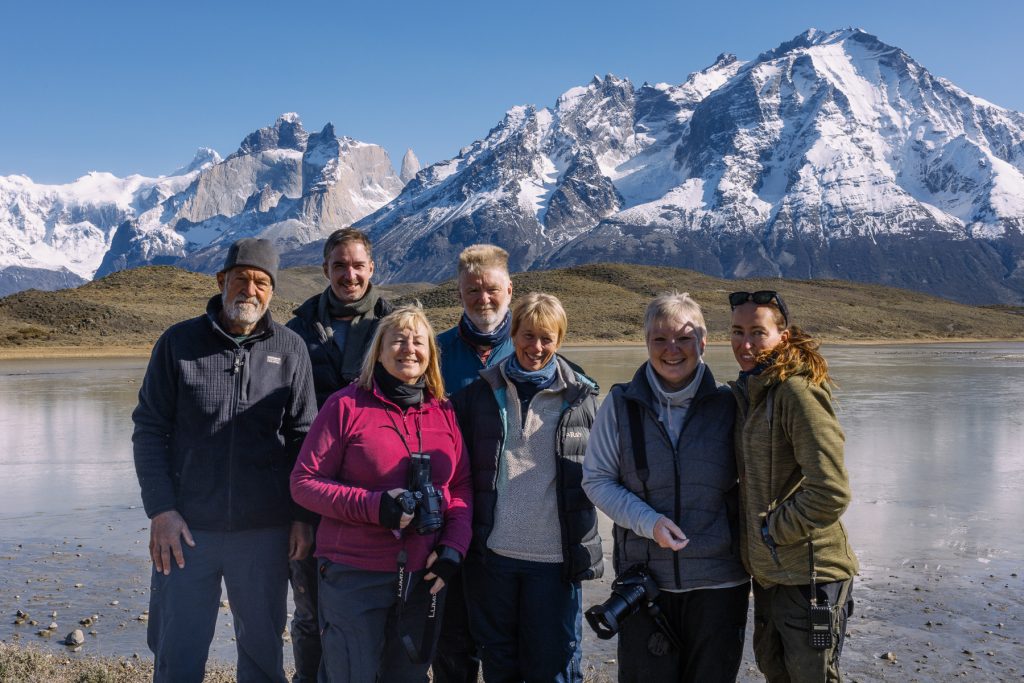
Our fantastic tour group, pictured in front of Lake Nordenskjold, Torres del Paine National Park, Chile (image by Virginia Wilde)






































































































